Session: Breathing at the Interface of Anatomy and Physiology
The Pulmonary Neuroepithelial Body Microenvironment: A Complex Multifunctional Unit in the Airway Epithelium
Sunday, March 26, 2023
4:50 PM - 5:15 PM US EST
Room: Grand Ballroom Salon III

Jean-Pierre Timmermans, PhD
Full Professor
University of Antwerp
University of Antwerp
Wilrijk (Antwerp), Belgium
Speaker(s)
Exciting new imaging and molecular tools, combined with state-of-the-art genetically modified mouse models, have recently boosted interest in pulmonary (vagal) sensory pathway investigations. In addition to the identification of diverse sensory neuronal subtypes, visualization of intrapulmonary projection patterns attracted renewed attention on morphologically identified sensory receptor end-organs, such as the pulmonary neuroepithelial bodies (NEBs) that have been our area of expertise for the past four decades.
This invited talk will provide an overview of the cellular and neuronal components of the pulmonary NEB microenvironment (NEB ME) in mice, underpinning the role of these complexly organized structures in the mechano- and chemosensory potential of airways and lungs. Interestingly, the pulmonary NEB ME additionally harbors different types of stem cells, and emerging evidence suggests that the signal transduction pathways that are active in the NEB ME during lung development and repair also determine the origin of small cell lung carcinoma. Although documented for many years that NEBs appear to be affected in several pulmonary diseases, the current intriguing knowledge on the NEB ME that came available the past 5 years encourage researchers that are new to the field to explore the possibility that these versatile sensor-effector units may indeed be involved in lung pathogenesis or pathobiology.
This invited talk will provide an overview of the cellular and neuronal components of the pulmonary NEB microenvironment (NEB ME) in mice, underpinning the role of these complexly organized structures in the mechano- and chemosensory potential of airways and lungs. Interestingly, the pulmonary NEB ME additionally harbors different types of stem cells, and emerging evidence suggests that the signal transduction pathways that are active in the NEB ME during lung development and repair also determine the origin of small cell lung carcinoma. Although documented for many years that NEBs appear to be affected in several pulmonary diseases, the current intriguing knowledge on the NEB ME that came available the past 5 years encourage researchers that are new to the field to explore the possibility that these versatile sensor-effector units may indeed be involved in lung pathogenesis or pathobiology.

